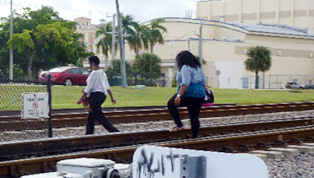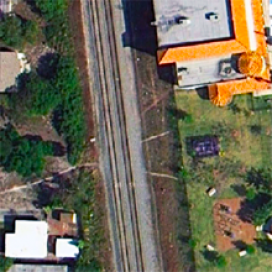Rail Trespass Prevention Research Will Save Lives
More than 500 people die each year while trespassing on rail lines. One particular stretch of rail in West Palm Beach, Florida, that has had a high incidence of trespass-related deaths over two decades, is currently the subject of a Federal Railroad Administration (FRA) and local community-based project being led by Volpe, The National Transportation Systems Center. This project is focused on finding and evaluating methods for reducing the number of trespassers on rail lines in order to decrease the number of trespass-related deaths.

Students crossing the tracks at a "No Trespassing" sign in West Palm Beach, Florida. (Volpe photo)
In West Palm Beach, two sets of train tracks intersect densely populated neighborhoods and carry commuter, freight, and Amtrak trains. At some locations, residents live on one side of the tracks, schools and stores are directly on the opposite side, with the nearest gated rail crossing several blocks away. This tempts residents to walk the shortest route, which is over the tracks, rather than walking a longer distance to reach a gated rail crossing. With an increasing amount of rail traffic, trespassers have frequent encounters with moving trains, and often receive little warning of approaching trains.
The challenge facing this community, and many others across the United States, is how to alter behaviors so people do not continue walking along or across tracks. Recently in West Palm Beach, the Florida DOT (FDOT) installed fences and barriers to block entry to the tracks. FDOT also installed signage to warn people about walking on the tracks, and local police have increased patrols along the tracks. A local community task force has worked to raise awareness.
The FRA, with Volpe's assistance, is using West Palm Beach as a test bed for its trespass prevention research study. Volpe project manager Marco DaSilva and operations research analyst Tashi Ngamdung are measuring the effectiveness of engineering, education, and enforcement strategies on preventing trespassing. According to DaSilva, "collecting accurate data on trespass frequency has been one of the bigger challenges we have faced."
To understand the frequency of trespassing and to identify the areas where trespassing is most prevalent, Volpe had to examine incident data, police citations, and video from cameras installed aboard commuter train locomotives. In a four-month period in 2010, the video analyzed from 613 commuter rail trips showed 116 trespass incidents where people were not at a proper grade crossing. Thus, on more than 20% of commuter rail transits, the train approached a person dangerously and illegally crossing the tracks.
Three general classes of trespass mitigation strategies are being evaluated. Engineering strategies include improving barriers, and building overpasses. Education strategies include signs, pamphlets, school-based education, and public service announcements. Enforcement strategies include patrols, fines, and legislative efforts.
As these strategies are implemented in West Palm Beach, the Volpe team will assess their effectiveness through follow-on analysis. The findings of these assessments will be incorporated into guidelines on trespass prevention that can be implemented by communities across the nation.
Partners and Stakeholders
The following organizations are collaborating to reduce rail trespassing in West Palm Beach:
- Amtrak
- City of West Palm Beach
- CSX Railroad
- Federal Railroad Administration
- Florida DOT (FDOT)
- Florida East Coast Rail
- Operation Lifesaver
- Palm Beach County
- Palm Beach County Sheriff's Department
- South Florida Regional Transportation Authority
- The School District of Palm Beach County
- Veolia Transportation
- West Palm Beach Neighborhood Associations
- West Palm Beach Police Department

A view of a shortcut across the tracks near the Boys and Girls Club in West Palm Beach, Florida. Fencing has been installed since this image was taken, causing trespassers to blaze new trails. (Google Maps)
